#meleki kalfa
Text
That is how they wrote Meleki out of the series? How lazy for a character that supposedly served Kösem loyally since she was a child. Like at least say Kösem send her somewhere else, married her off or asked her to retire to some estate she gifted her but just handing Lalezar the job and saying it is hers now feels not enough.
11 notes
·
View notes
Text

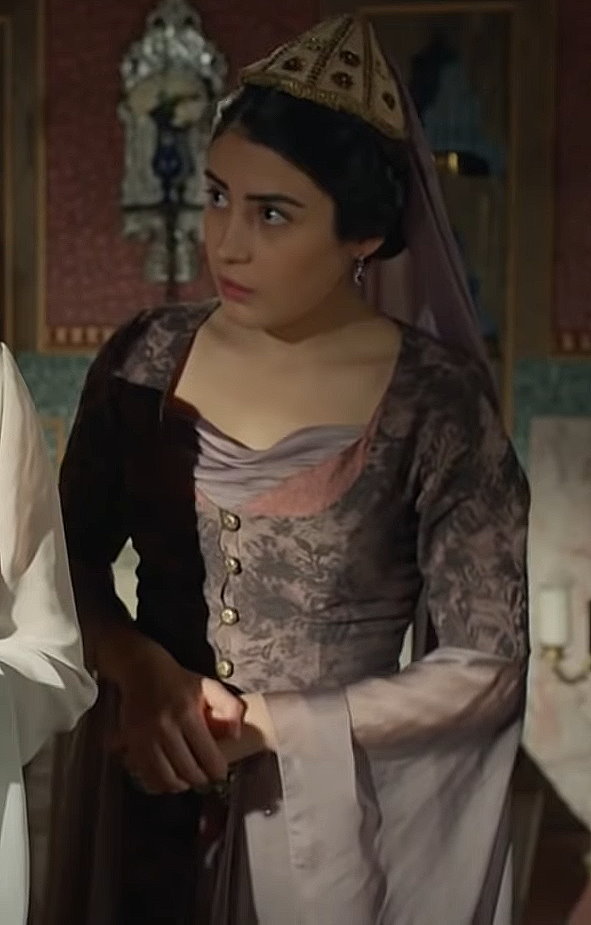

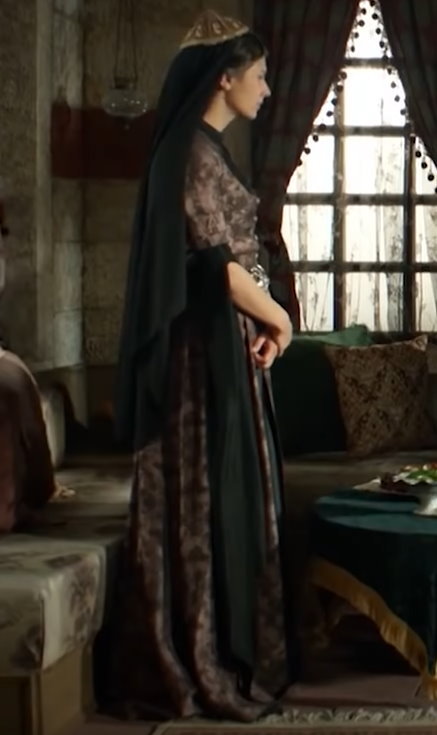

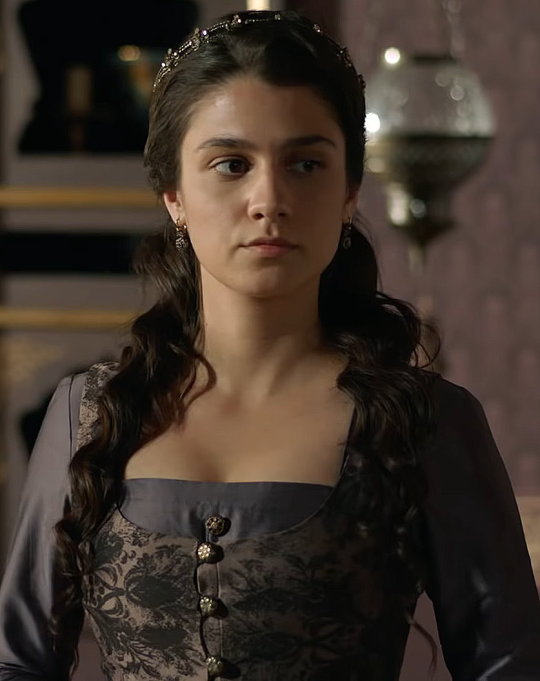
This pink and grey kaftan was first worn by Mahidevran Sultan in the first episode of the third season of Magnificent Century. It appeared again three times in the fourth season, first on Melek Kalfa in the thirteenth episode, then on an unnamed harem member in the twenty-third episode and lastly on Fidan Kalfa in the twenty-sixth episode.
Magnificent Century: Kösem removed the sleeves and used the kaftan on Menekşe Hatun in the first episode of the first season and on Meleki Hatun in the sixth episode of the second season.
#Muhteşem Yüzyıl#Muhteşem Yüzyıl: Kösem#Magnificent Century#Magnificent Century Kösem#Magnificent Century Kosem#period drama#costume drama#historical drama#Mahidevran Sultan#Melek Kalfa#Melek Kalfa (Servant of Fatma Sultan)#Unnamed Harem Members#Fidan Kalfa#Fidan Hatun#Menekşe Hatun#Menekse Hatun#Menekşe Hatun (Servant of Halime Sultan)#Meleki Hatun#reused costumes#recycled costumes
11 notes
·
View notes
Text
10 most Influential women in the Ottoman Empire (plus five non- sultans)
I must say in advance, this is purely my opinion and it doesn't include legal power,but general influence. For example if one woman had more legal power but still was limited to some actions, that another woman could get away with, I will rank her higher. Let's start with non sultans.
Part I: Non-Sultans
Number 5: Çevri kalfa

Çevri kalfa was a woman of Georgian origin and previously loyal servant to Nakşidili Sultan (also Georgian). She became mistress head treasurer( Baş hazindar usta) after accession of Mahmud II, who she saved from executioners by throwing them hot coals and sneaking the prince out. After becoming Head treasurer, she attained so much wealth that she could afford expensive clothes not even sultans wore. A girls school, built in her name, is one of the first schools for girls and the biggest primary school in Istanbul. She remained in her office until her death and was Sultan's trusted and favoured advisor.
Number 4: Meleki Kalfa

Meleki kalfa was a servant of Kösem and Ibrahim, however following the deposition of the sultan, she secretly switched sides as an agent of Turhan. Meleki played an important role in Turhan's rebellion by giving her information about Kösem's plan to dethrone Mehmed. After Kösem's death and Turhan's accession, she became an important person in Valide Sultan's court, was freed and married to Şaban Khalife. The couple built a residence in Istanbul, where Meleki not only conditioned her line of information to Turhan, but also acted as a negotiator in the palace on behalf of people. The political influence of her and her husband grew so much and they were murdered in 1656 for abuse of power.
Number 3: Gulfem Hatun

I have spoken about her in my previous posts
Number 2: Mahidevran Hatun
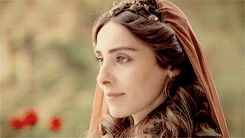
I have thought a lot about where to put her. People would expect her to be Number 1,mostly because they are used to her being sultan. That is what I first thought,for other reasons,but here we are. She has several significant influences that not many other women had:
1. She was popular with janissaries and people
2. Had a spy network, allowing her to hear major events happening in the capital.
3. She had strong allies. Ibrahim Paşa supported her and Mustafa later in his life, Hatice and her husband were supporting her openly or indirectly.
4. She was a considerable rival to the first and one of the most powerful women in the ottoman empire.
5. She had powerful characteristics: Was an intelligent, educated woman. Could mask her resentment towards Hürrem and act calmly around him.
6. She was a trusted advisor to her son. Actually, she supported the idea of Mustafa revolting against Suleiman,but only after she received information about his imminent execution, through her spy network.
Number 1: Çanfeda Kalfa

Çanfeda was the woman of Circassian origin, who served as second in command of Nurbanu for 18 years and the ruler of harem for another 11, so we can say she was de-facto Valide sultan.
In her almost three decades of service, she acquired wealth, so great that it attracted negative attention of Janissaries and even the grand Vizier. Although she collected such affluence through her salary(that was extraordinarily high consisting of 200 akches a day, it was the average salary of an imperial princess) and bribery, she used it for selfless purposes. She built three mosques, fountains, hamams, two schools, irrigation systems and fixed the roads, costing her several million akches, still she remained as one of the wealthiest people in the empire. In 1595, when Safiye exiled her, she needed dozens of carriages to carry her holdings, which apparently did not consist of much of the furniture, because she bought it from Venice the next year. It's also considerable that as an exiled person, she had to give up some of her wealth to imperial treasury.
Apart from her vital involvements in harem management in which she dominated Safiye, she had considerable influence over state matters as well. Çanfeda used her connections to install her not so bright brothers as paşas and after the series of mistakes,they were imprisoned, Çanfeda not only defied Grand viziers orders and had them set free,but restored them to their offices as well. Her power, wealth and influence came to the attention of Janissaries, who demanded her dead, but she got away with this as well. Another indication of her power, was her attempt to free the second son of sultan Murad. Even though she was caught red handed, the power it would take to infiltrate the prison is still considerable.
P.S. I did not list Halime and Handan,because after becoming Valide Sultans and regents they reached a whole different level, leagues above almost every single woman in ottoman history, however their power and influence was immense even when they were Hatuns.
As there is only 10 images/Gif limit. I will speak about 10 most powerful women in second posts.
#history#historical drama#16th century#magnificent century#magnificent century kosem#mc: kosem#medieval women#ottoman empire#ottomanladies#historical events#canfeda hatun#gulfem hatun#mahidevran hatun#mahidevran sultan#ottoman sultanas#ottoman history#ottoman#women in politics#sultanate of women#women in history#historical figures#historical#historyedit
70 notes
·
View notes
Text
Which MC/MCK Character Belongs To Heaven? A Tier List
(All celestial realms only have three circles because I am lazy. Haven’t seen season 2 of Kösem in full, so I didn’t dare to judge. Also, this is about actual morality, quality as a character, as well as about how much I like them.)
Heaven
1st circle (second only to Jesus in God’s eyes): Cihangir, Gülnihal, Leo, Bülbül aga
2nd circle (mistakes were made, but overall we’ve canonized worse people): Anastasia!Kösem, Afife, Daye, Gül aga, Matrakçi, Sadika, Gölge, Sayeşte, Hüsrev pasha
3rd circle (heaven is half-empty anyway, I guess you’ll do): Bayezit (MC), Isabella Fortuna, Armin, Beyhan, Isabella Fortuna, Şeker aga, sultan Ahmet, Mehmet Giray, Mihrünissa, sultan Mustafa, Zülfikar
Purgatory
1st circle (a few months and like one forgiven murder from heaven at most): Hatice, Ayas pasha, Ayşe (MC, season 1), Cevher, Ebu Suud, Efsun, Firuze, Lokman aga, Nigar kalfa, Sümbül, Cennet, Derviş pasha, Handan, sultan Osman
2nd circle (your sins don’t outnumber the times you made this show infinitely better by your mere presence): Hürrem, Mahidevran, Fatma sultan, Mercan, Nurbanu, Şah, Fahriye sultan, Gabriella de Sfeo
3rd circle (I hereby sentence you for being a boring bitch): şehzade Mustafa, Aybige, Dudu, Elif, Esma, Fidan, Helena, Nurbahar, Nazli, Nilüfer, Atmaca, Halil pasha (MCK, s1), Iskender, Yavuz, Zümrüt aga, Fahriye kalfa, Rümeysa, Ayşe (MC season 3), Hadim Süleyman
Limbo (Who? I mean, those I don’t remember well enough): Alvise Gritti, Defne, Iskender pasha, Pedro, Anne of Poland, Gazanfer, Canfeda, Gracia Mendes, Kara Ahmet pasha, Lala Mustafa pasha, Piri pasha, Sinan pasha, Sokollu Mustafa, shah Tamhasp
Hell
1st circle (Satan has a super rad party here and guess what, you’re invited): Fatma (MC, seasons 2&3), Gülşah (see, it’s hell cause they are here together), Rüstem pasha, Safiye, Dilruba, Halime, Davut pasha, Menekşe, Şahin Giray
2nd circle (your only sin is being annoying but boy have you sinned): Mihrimah, s1!Kösem, Esmahan, Huricihan, Nazenin, Taşlicali Yahya, Ahmet pasha (MC, season 1), Haci Mustafa, Hümaşah (MCK), Katerina (MCK), Kiraz aga, Mahfiruz, Mahfiruze, şehzade Mehmet (both)
3rd circle (Fuck you. Just fuck you.): Ayşe Hafsa, Gülfem, Bali Bey, Barbarossa, Louis II. of Hungary (the character, not the historical king whom they absolutely butchered, asjgh...), Meleki, Kuyucu Murat, Zal Mahmut
Superhell (for all of your gay crimes: Ibrahim pasha, Süleyman, Lütfi pasha (he’s not gay, but he is probably homophobic, so this is a double superhell for him), Reyhan aga
17 notes
·
View notes
Photo
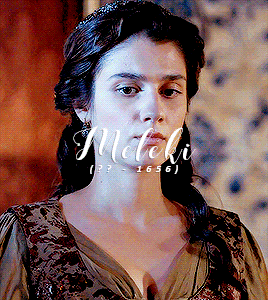



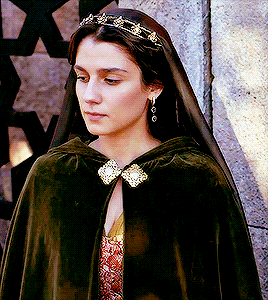

(OTTOMAN) WOMEN’S HISTORY MEME | 5 harem servants: Meleki Hatun
Meleki was originally a member of Kösem Sultan’s suite. [...] When, however, Turhan began to assert what she saw as her rightful authority, Kösem reportedly planned to depose the young sultan and replace him with another prince, whose mother she believed more tractable. At this point Meleki deserted Kösem and betrayed her plans to Turhan, thus enabling the latter to eliminate her mother-in-law (Kösem was murdered in a palace coup led by Turhan’s chief black eunuch). Meleki became the new valide sultan’s loyal and favored retainer. She was eventually manumitted and married to Şaban Khalife, a former page in the palace training school. The couple established residence in Istanbul, where, as a team, they were ideally suited to act as channels of information and intercessors on behalf of individuals with petitions for the palace. Şaban received male petitioners, Meleki female petitioners; Şaban exploited contacts he had formed while serving within the palace, while Meleki exploited her relationship with Turhan Sultan. The political influence of the couple grew to such a point that they lost their lives in 1656 when troops stationed in Istanbul rebelled against alleged abuses in government. — Leslie Peirce, The Imperial Harem: Women and Sovreignty in the Ottoman Empire
148 notes
·
View notes
Photo





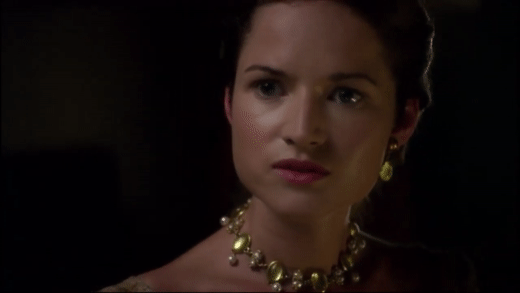

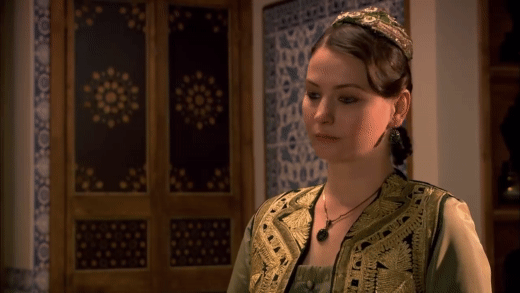


Servants, attendants, and ladies in waiting- Kalbimin Sultani, Moon Embracing the Sun, Muhtesem Yuzyil: Kosem, Muhtesem Yuzyil and The Tudors
#servant#servants#attendant#attendants#lady in waiting#ladies in waiting#moon embracing the sun#kalbimin sultani#sultan of my heart#muhtesem yuzyil kosem#magnificent century kosem#muhtesem yuzyil#magnificent century#amber aga#eun#meleki hatun#esma hatun#cervi kalfa#jane rochford#jane parker#sumbul aga#gulsah hatun#Cennet Hatun#Cennet Kalfa#ayperi hatun#period drama#historical drama#historical tv#fictional characters#historical characters
14 notes
·
View notes
Text
Watching MYK episode 54 (S2E24), another surprise by TIMS. Madam Margaret (prenses Farya’s nanny) now converted to muslim, it’s funny that she cared to convert whereas her prenses never bothered to convert and change her name at all (LOL). On top of that, she is renamed as Melek now, welcome Melek kalfa.
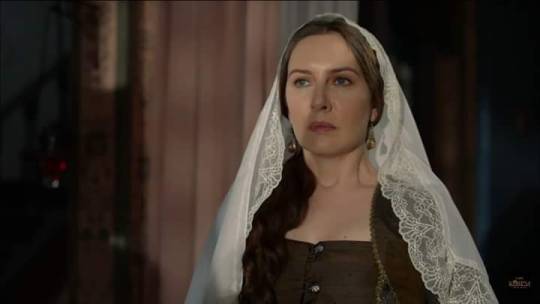
BUT WAIT!!! Does this mean that Meleki hatun got replaced by her, remember this girl from season 1?:

And her grown up version:
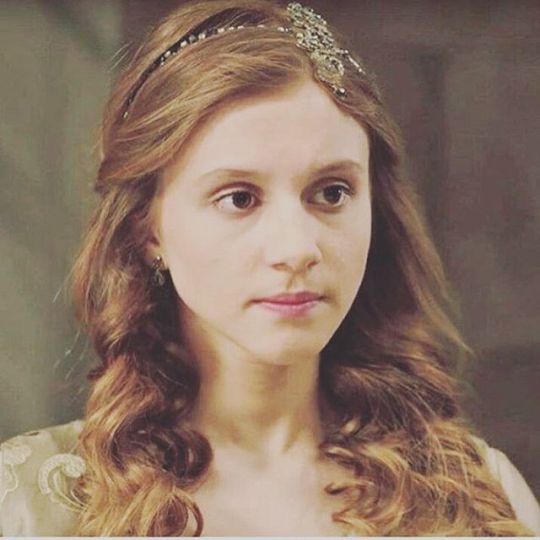
The girl named Meleki, she was a little girl saved by Kösem sultan when her mother died by illness and later she saved Kösem back by hiding her during Safiye’s coup d’etat, since then she became Kösem’s loyal servant until she had been sent away from the palace (iirc because Kösem thought that she was incompetent) in episode 38 (S2E8). You know, this Meleki hatun was famous enough as Kösem’s loyal servant who betrayed her in the end by exploiting Kösem’s plan to Turhan Hatice that she would replace Mehmed by another grandson, removing Turhan Hatice as Valide Sultan with another sultana who could easily be controlled, leading to Kösem’s death by murder.
I mean, will this girl Meleki hatun back and continue her role? Or will she be magically gone and replaced by the old Melek kalfa?? If so, what is the reason?
Could it be the last woman played as Meleki hatun has left the show for specific reason and madam has to replace her? With the similar situation that have happened before in Mahfiruz’s role. Remember this Mahfiruz hatun who got infected by smallpox and died:


And later came Rasha hatun who became Mahfiruze Hatice Sultan:

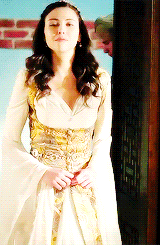
Or could it be another favoritism for Farya since her fans demand that her death by Kösem to be avenged? Will Kösem die by Turhan with Melek kalfa’s help? If so, I wonder why this favoritism has not ended yet even when the actress has stopped playing in this show and is currently busy shooting for her next drama?
I wish this is not the case, I hope Melek kalfa is a separated and different individual and the previous Meleki hatun will come back soon. Because I don’t want another favoritism for Farya when it only caused the disruption and confusion to the story that has been built and established before.
I think it’s enough for Farya became Murad’s legal wife without converting and changing her name, became a sultana without having a sehzade first in Episode 40 (S2E10), ditching the fact that Ayşe Haseki Sultan was the most beloved and held the highest position as Murad IV’s consort, twisted Ayşe Haseki Sultan’s role as Mahidevran 2.0 and died as traitor in Murad’s eyes. It’s enough for Farya had dramatic miscarriage in episode 39 (S2E9) only to have miracle twins sehzade in episode 52 (S2E22). Please, don’t force the story to have madam (as Melek kalfa) avenges Farya’s death by killing Kösem and abandon/defying previous Meleki’s existence like she is never existed, though I’m sure it will happen soon.
Honestly, I prefer a random woman appears and comes to Turhan that she is Meleki hatun, a loyal servant of Kösem sultan that had been sent away from the palace by Kösem and felt betrayed by her then decided to help Turhan instead than madam Margaret as Melek kalfa who suddenly replaces Meleki hatun’s role.
I wish TIMS had planned their story better from season 1 to season 2 (or 3 from their initial planning), perhaps I will be okay with madam becomes Melek kalfa if only little Meleki hatun from season 1 never existed.
#muhtesem yuzyil kosem#meleki hatun#melek kalfa#mahfiruz sultan#madam margaret#my thoughts#episode 54 spoilers#magnificent century kosem#poor kosem sultan#she will get murdered soon#turhan does kill kosem for heroic thing#but people will likely forget it#because they're busy for thinking that turhan will kill kosem to avange farya's death#i'm sure turhan doesn't give a shit about farya#because she did it for her son mehmed iv#and perhaps for the sake of the Ottoman state
25 notes
·
View notes
Text
The Rise and The Fall of Kosem Sultan (Part II - Episode I)
Kosem Sultan: Rise to Power Episode I

continued from ⤵️
Anastasia left Ahmed's Room and went to face rebels. She reached there and told them that Sultan and Shehzade Mustafa are alive however their health is in critical condition. She assured them that she takes guarantee that Palace is telling truth and is not hiding anything. She also told them to go back and return after sometime to see Sultan well and fine. When rebels started to disperse one of them shot Anastasia and she fell down. After a moment Anastasia became conscious and stood up. This was due to Taveez (object of protection) given by Aziz Mehmud Hudayi. Anastasia came back to the palace and was taken to palace clinic for medical aid. The rebels finally dispersed and on the other hand Anstasia's father reached Isatanbul in search of his daughter. Next morning everyone praises Anastasia including Valide Sultan. She is presented as the Hero in front of everyone in the palace and then due to her heroic acts she was named Kosem (the leader). Ahmed's condition improved but he was unconscious. There was chance of another rebellion so for speedy recovery Kosem went to Fortune Teller Magician who gave her a medicine and told her that Ahmed will be fine only at one cost, that Kosem will see the death of all her loved ones, she accepted this and took the medicine. On the other hand her father is still in search of her. Safiye made pact with Giray brothers, the Crimean Hans (thinking that Ahmed and Mustafa would die soon) that Sahin Giray will acsend the ottoman throne. The coronation preparations were complete. On the same day of Sahin's coronation Ahmed suddenly woke up fine and in good health. When Sahin was about to be declared Sultan, by everyone's surprise Ahmed came to durbar, beheaded the minister and proclaimed that he's still the Sultan and will punish everyone who created problems during his illness. Kosem then came to meet him and he called her Nasia, she replied that she is not Nasia, Anastasia, Hatice or Mahpeker. From now onwards she is KOSEM.

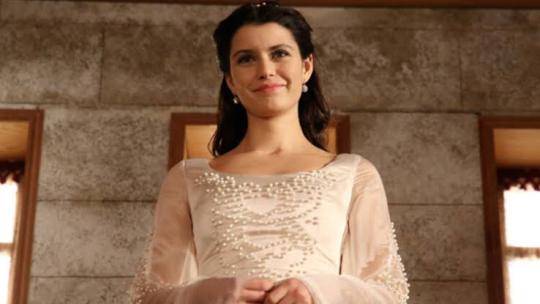

Kosem breaks her alliance with Safiye after watching her actions during Ahmed's illness. Kosem's father found her through the help of Alexander (now Iskender) but Safiye learns about this and arrests him. Kosem learns that it was Fahriye who poisoned Ahmed and Mustafa due to her love interest. Safiye threatens her that she'll kill her father if she tells this to Sultan. She uses Kosem and then kills her Father. Fahriye is not married with Mehmed Giray (her love interest) instead she is married to Dervaish Pasha (closest to Ahmed) which Ahmed approved and wedding preparations began. On the other hand Dervaish Pasha confesses his love for Valide Sultan Handan to her about which she's angry but she spares his life despite this. Kosem pledges to take revenge of her father. Cennet Kalfa (Safiye's Confident) is told by Kosem that the reason of her burnt face is Safiye. When she was Mehmed III concubine, it was Safiye who schemed against her and burnt her face. Cennet after learning this switched her side secretly and gives Kosem the ring of her mother which her father brought from Tinos which Safiye kept with her. Kosem threatens. Safiye that she will tell everything to Sultan but she didn't give any attention to her. Kosem schemed and caught the letter of Fahriye in which it was written that she poisoned Sultan. She showed this letter to Safiye and told her that she will return this letter only if she leaves the Topkapi Palace and shifts to Aski Palace. Safiye agreed and left for Aski Palace. On her way when she unfolded Fajriye's letter given by Kosem she found out that it was simple paper and Kosem had played with her and the letter is still with her. Cennet confesses that she helped Kosem and she officially changed sides. Sultan gives Kosem the crown of great Hurrem Sultan. Kosem walks in the palace as if shes the queen. Kosem hands over the letter to Ahmed and told him all the truth about Fahriye. He despite of this becomes disappointed from Kosem as he said that he only liked her due to her Innocence but now she's no more innocent as she is also scheming like other Sultanas.
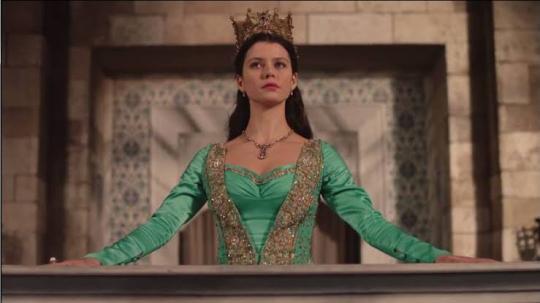
On the other hand Mahfiruz gives birth to Sultan's first child a son named Osman. This created jealousy in Kosem's heart. Sultan is not talking to Kosem and she is not allowed to visit him nor to come in his room. Kosem learns that she's pregnant and soon she gives birth to Sultan's second son Mehmed. Sultan is still not taking to her so she decided to tell him whole truth about the murder of her father. She told him that she only took revenge from Safiye because she killed her father. After learning this his heart melts and he is reunited with Kosem. Fahriye on the other hand takes refuge in Mahmood Hudayi Welfare where it is not allowed to kill anyone. Ahmed tries to get her out but she didn't. Kosem again schemed with Zulfikar Pasha and Mehmed Giray and made her come out of the welfare and then arrested her. Sultan praises the efforts of Kosem and Zulfikar. She is presented to Sultan and she pleads him to forgive her. He tells him that he'll think about this matter. Fahriye settles back in her place with Dervaish Pasha where he executes her on the order of Sultan Ahmed. Safiye when learns about her daughter's executions goes into. Deep sorrow and pledges to take revenge from Ahmed.

Ahmed goes to hunt with his guards where he faces assassination attempt on himself but he was saved by Dervaish who put his life in danger. Safiye starts rebellion in palace. She told Jannisaries that Ahmed is no more. They believed and sided with her. She planed to put Mustafa on throne. Kosem saves the life of Valide Sultan, Osman and Mehmed however unfortunately Mahfiruz is killed by Safiye's guards. Safiye ordered execution of Kosem but she is spared by Bulbul (Safiye's Agha) who admired her. She along with Valide and her son's took refuge in a girl's house named Meleki. At the time of Mustafa's crowning Ahmed, by everyone's surprise appeared and kills pashas who sided with Safiye. Zukfikar and Mehmed Giray sided with Ahmed. Safiye tries to poison herself but she is caught by Ahmed who then imprisoned her. All her accessories and property was taken away. Humashah (Safiye's daughter) arrives in the capital.


Kosem learns from Halime (mother of Mustafa) that Handan and Dervaish are in love with each other and that Dervaish killed Mehmed III. Kosem schemed again but now against Dervaish and Handan, she managed to tell Sultan about Dervaish. Humashah on the other hand falls in love with Zulfikar Pasha. She's living in the palace and was convincing Sultan to release Safiye. Sultan learns that Dervaish killed Mehmed III only to save Ahmed's life however Ahmed executed Dervaish. (Who was then Prime minister) on charges of Sultan's murder. Handan commits suicide in fear that Ahmed will learn about her love and also because she was in deep sorrow after the execution of Dervaish. Palace mourns the loss of Valide Sultan. Huamshah is made incharge of Harem.

After sometime Safiye is released. Humashah's husband comes to. Capital and asks Sultan to let Humashah go with him but she refuses. Humashah and Safiye learns that Iskender is Shehzade Safiye's son and Humashah's brother. Kosem learns that she is again pregnant. She tells this good news to Sultan who then makes her incharge of Harem.
Kosem after so much struggle finally managed to rule Harem.
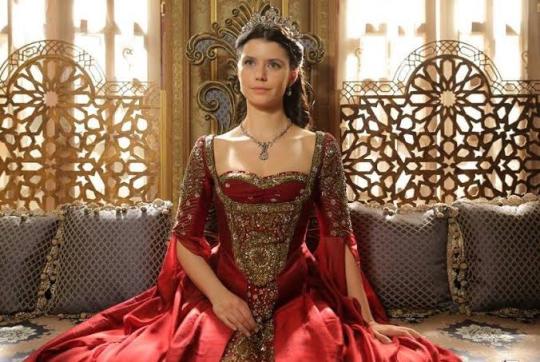
To be continued
Coming up next - Kosem Sultan: Rise to Power Episode 2
8 notes
·
View notes
Text
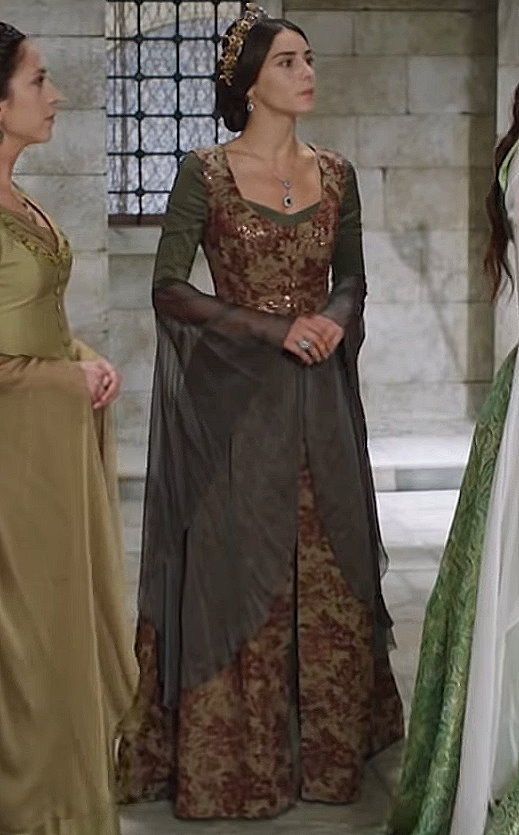
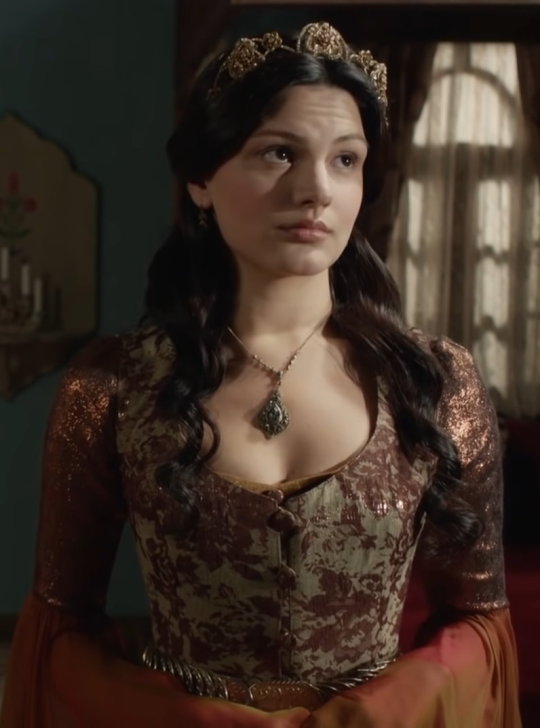



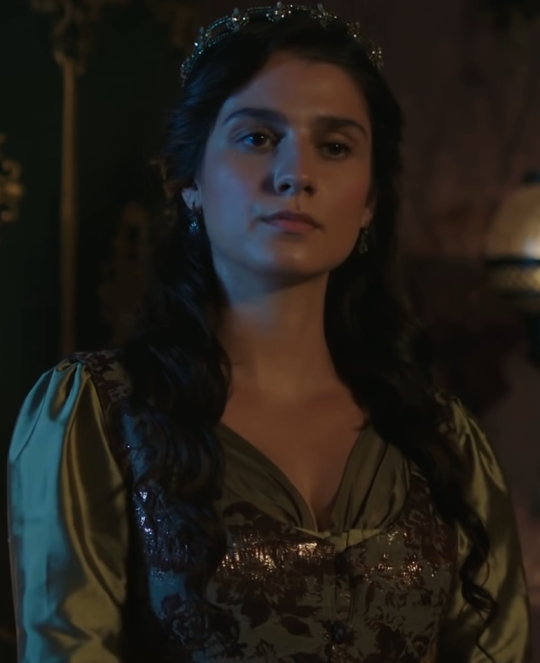

This brown and red kaftan was first worn by Mahidevran Sultan in the first episode of the third season of Magnificent Century. The kaftan was used three times in the fourth season where it was worn by Nazenin Hatun in the fourth episode, by Canfeda Hatun in the twenty-first episode and by Fahriye Kalfa in the twenty-sixth episode.
It also appeared in the spin-off Magnificent Century: Kösem where it can be seen on Menekşe Hatun in the seventh episode of the first season. The kaftan was also worn by Meleki Hatun in the first episode of the second season as well as by an unnamed harem member in the twenty-fourth episode.
#Muhteşem Yüzyıl#Muhteşem Yüzyıl: Kösem#Magnificent Century#Magnificent Century Kösem#Magnificent Century Kosem#period drama#costume drama#historical drama#Mahidevran Sultan#Nazenin Hatun#Canfeda Hatun#Fahriye Kalfa#Menekşe Hatun#Menekse Hatun#Menekşe Hatun (Servant of Halime Sultan)#Meleki Hatun#Unnamed Harem Members#reused costumes#recycled costumes
10 notes
·
View notes
Text




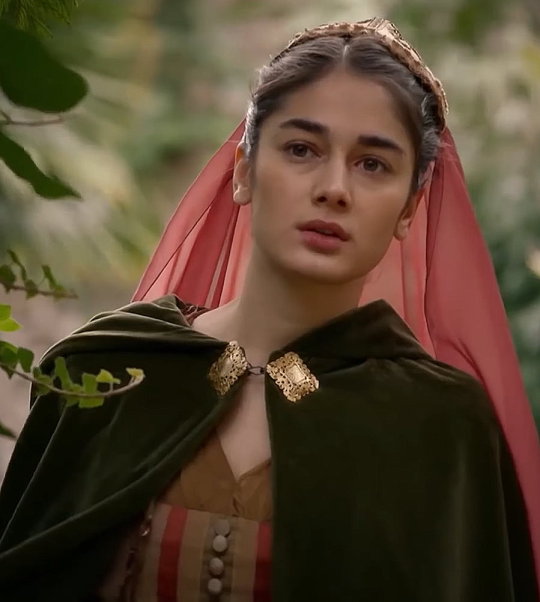

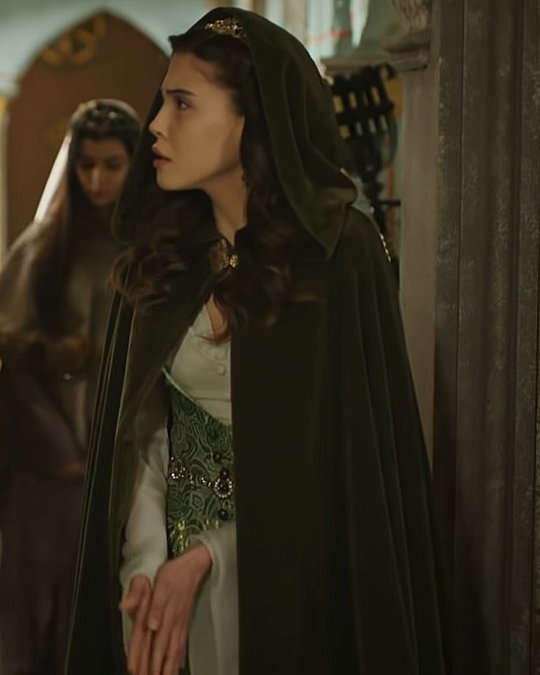

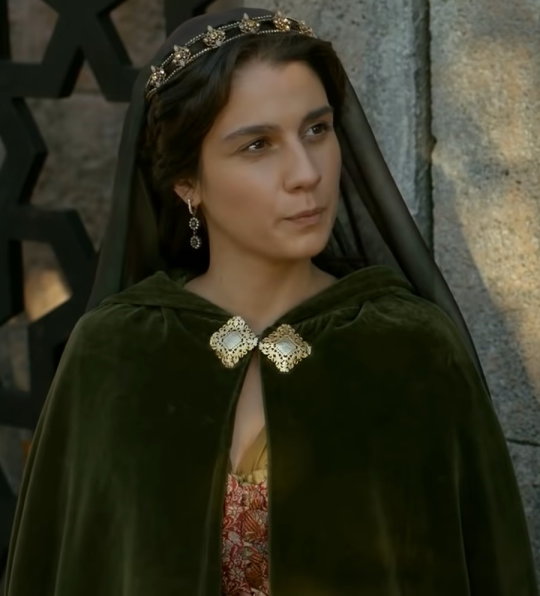

This green cloak was first worn by Daye Hatun in the eighth episode of the second season of Magnificent Century. Three episodes later, it was worn again by Hatice Sultan. The cloak made another appearance on Nigar Kalfa in the ninth episode of the third season. The cloak was used three times in the fourth season, first on Fahriye Kalfa in the twelth episode, then on Gülbahar Kalfa in the fourteenth episode and lastly on Defne Sultan in the thirty-fourth episode.
Magnificent Century: Kösem saw the cloak on Mahfiruze Hatun in the sixth episode of the first season. The cloak also appeared twice in the second season, first on an unnamed harem member in the second epsiode and then on Meleki Hatun in the fourth episode.
It is also used on an unnamed harem member in the third episode of Mehmed The Conqueror (2018).
#Muhteşem Yüzyıl#Magnificent Century Kosem#Muhteşem Yüzyıl: Kösem#Magnificent Century#Magnificent Century Kösem#Mehmed Bir Cihan Fatihi#Fatih#Fatih (2018)#Mehmed the Conqueror (2018)#period drama#costume drama#historical drama#Daye Hatun#Hatice Sultan#Hatice Sultan (Daughter of Hafsa)#Nigar Kalfa#Nigar Hatun#Fahriye Kalfa#Gülbahar Kalfa#Gulbahar Kalfa#Defne Sultan#Mahfiruze Hatun#Mahfiruze Sultan#Rasha Hatun#Unnamed Harem Members#Meleki Hatun#reused costumes#recycled costumes
17 notes
·
View notes
Text


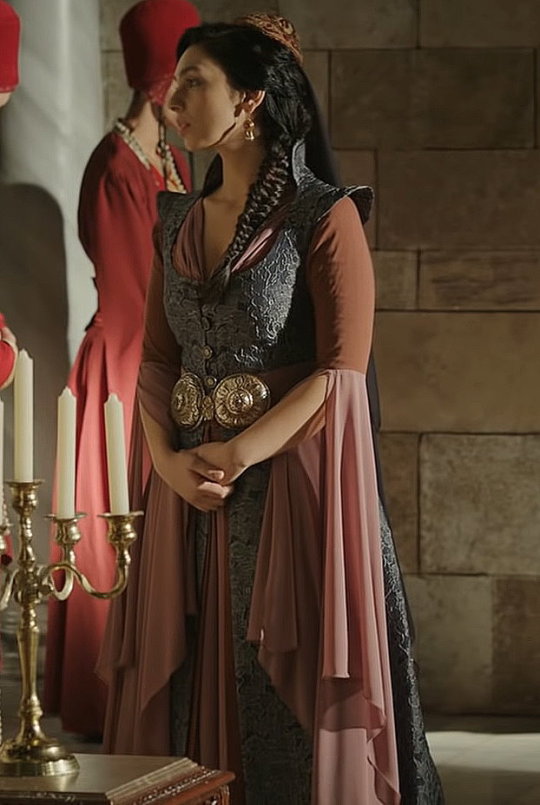
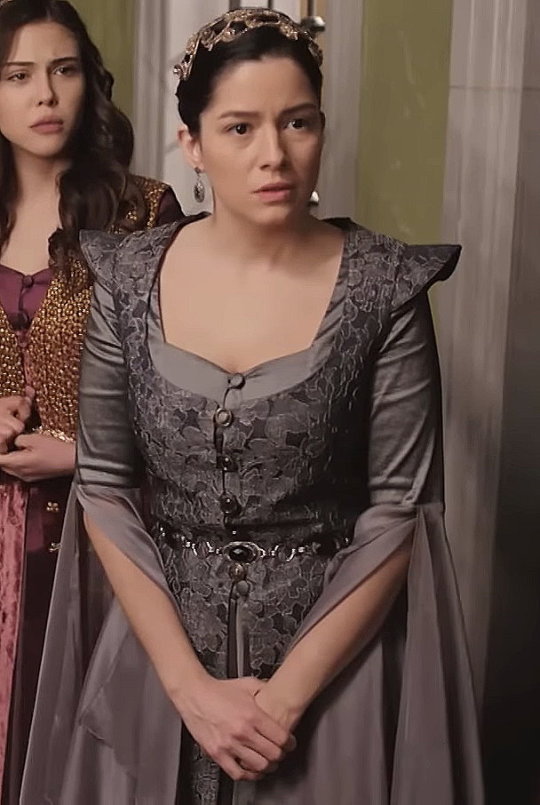

This blue lace kaftan first appeared on Hürrem Sultan in the twenty-eighth episode of the third season of Magnificent Century. It was briefly worn again by Fatma Sultan in the twenty-third episode of the fourth season.
Magnificent Century: Kösem used the kaftan again on Handan Sultan's kalfa Gülperi Hatun in the fifth episode of the first season. Firdevs Hatun also wears the kaftan in the twelth episode of the same season. The kaftan makes another appearance in the second season where it is first seen on Meleki Hatun in the third episode.
#Magnificent Century#Magnificent Century Kösem#Magnificent Century Kosem#Muhteşem Yüzyıl#Muhteşem Yüzyıl: Kösem#period drama#costume drama#historical drama#Hürrem Sultan#Hurrem Sultan#Fatma Sultan#Fatma Sultan (Daughter of Hafsa)#Gülperi Hatun#Gulperi Hatun#Firdevs Hatun#Meleki Hatun#recycled costumes#reused costumes
10 notes
·
View notes
Note
Could you tell me influential kalfas? I saw the gif but I want some information from them please!
Canfeda Hatun: most probably the first official harem stewardess (kethüda hatun) of the harem in Topkapi Palace, she was called from the Old Palace by Nurbanu Valide Sultan. After her death, Canfeda assumed the full management of the harem — as Nurbanu wanted — and even endowed two mosques: one in Istanbul and another in a village outside the city. She also built two schools, a public fountain, a fountain and a public bath. At its highest, her stipend was 200 aspers a day, almost the stipend of a princess.
Meleki Hatun: chief administrative office of the harem (kahya kadın) during Sultan Ibrahim's reign, she was a trusted servant of Kösem Sultan's until she "betrayed" her when she told Turhan Hatice Sultan of her plan to depose Mehmed IV for his younger brother, Suleyman II. After Kösem Sultan's death, Meleki became Turhan Sultan's "loyal and favored retainer". She eventually married Şâ'bân Halîfe and the two used to receive petitioners in their Istanbul house. She reportedly dressed more magnificently than the sultan himself, who would call her "aunt" in public. Her political influence was such that she was killed by a mob in 1656 and her body strung up on a tree.
Cevri Usta: harem treasurer of Mahmud II, she was one of his mother's kalfas. During Mustafa IV's deposition, she burned her own hands throwing hot coals to executioners who wanted to kill Mahmud (and therefore nullify Mustafa IV's deposition, as he would become the only male alive). Mahmud II never forgot what she did and promoted her to the rank of harem treasurer during his reign. In her honour, he built a fountain and a school in Sultanhamet.
Şehsüvar Usta: better known as Şekerpare Hatun, she was a high-ranking servant in Kösem Sultan's retinue until she became one of Sultan Ibrahim's female companions (musahibe). As such, she became highly influential and advanced the careers of several people, among whom her husband, Musa Paşa.
I know that technically ustas are not kalfas but ustas are more high-ranking than kalfas so it's more likely that they were influential.
#anon#ask post#ask: ottoman history#ottoman harem#canfeda hatun#meleki kalfa#cevri kalfa#sekerpare hatun#Anonymous
24 notes
·
View notes
Photo



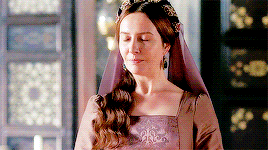


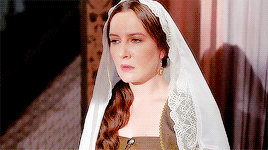

On this day in Ottoman history, Meleki Hatun was assassinated by rebels:
“Five days after the beginning of the uprising, the criers ordered the shops to reopen. Eremya Çelebi recalled seeing the Sultan’s nurse Meleki Hatun, who had been responsible for betraying Kösem Sultan’s plot to Turhan Sultan, being taken away before she was murdered and strung up in a tree. Three days later the relatives of those hung from the plane trees were ordered to come and retrieve the corpses. The reign of terror continued during the following weeks.” – Caroline Finkel, Osman’s Dream: The Story of the Ottoman Empire 1300-1923
298 notes
·
View notes
Note
Hey this a question about Köçeks and their connection to the Harem but also LGBTQ in the harem and the empire. I read somewhere that court dancers and concubines, jealous of attention to the boys killed them? What about eunuchs? Did women of the Harem ever have affairs with them? How did castration become a thing in the first place and who decided who was castrated vs. who was a slave soldier? Do we know if women had affairs with other women in the harem? What about the eunuchs?
I'm sorry, köçeks have no connection to the harem. They were entertainers in the city (taverns, pubs?, clubs, etc) not in the palace.
It seems you have read the wikipedia page about them because it says:
Köçeks were much more sought after than the çengi ("belly dancers"), their female counterparts. Some youths were known to have been killed by the çengi, who were extremely jealous of men's attention toward the boys.
And, again, belly dancers were not harem dancers or court dancers. So, no, no one from the harem killed köçeks.
About eunuchs, Croutier says:
The first traces of eunuchry appear in Mesopotamia, the cradle of civilization, between the rivers Tigris and Euphrates, which eventually become one and empty into the Persian Gulf. In that delta, a beautiful valley nurtured many tribes— predominantly matriarchal societies. During the ninth century B.C., Semiramis, queen of Assyria, castrated male slaves. So did other queens. — Harem: The World Behind the Veil
I seem to remember that the Byzantines employed eunuchs in the Royal Palace and that is how eunuchs ended up being employed in the Imperial Harem of the Ottoman sultans.
And indeed Croutier says about this:
During the fourteenth century, when the Ottomans first began secluding their women, the Byzantines supplied them with eunuchs, but it did not take the Turks long to establish their own trade. — Harem: The World Behind the Veil
Eunuchs could not be castrated by Muslims so they were sold already castrated. It was Christians and Jews who castrated them
Egyptian Christians or Jews castrated some young black boys on the way at rest stops, since Islam prohibited the practice. It was a risky operation with a high mortality rate, and the hot, arid climate was not conducive to easy recovery. Desert sand being considered the most efficacious balm, the newly castrated were buried up to their necks until their wound healed. The boys who survived the pain, hemorrhage, and subsequent burial became luxury items, bringing enormous profit to the traders. And since they attracted wealthy purchasers, the eunuchs’ futures actually held opportunity for position and power. — Harem: The World Behind the Veil
Talking about sexual relations between concubines in the harem is a very risky thing because most of the people who reported them did so to feed the image of the harem as a world of sexual perdition. An example:
“It is common knowledge that as a result of this familiarity in washing and massaging women fall very much in love with each other. And one often sees a woman in love with another one just like a man and woman. And I have known Greek and Turkish women, on seeing a lovely young girl, seek occasion to bathe with her just to see her naked and handle her.” — Harem: The World Behind the Veil
Another rumour is that they could not serve entire vegetables to the concubines because they would use cucumbers or similar vegetables to pleasure themselves... which is something clearly written to shock Europeans.
Of course we cannot exclude lesbian relationships in 700 history of harem seclusion but I'm quite sure they were kept a secret because I doubt that the sultan would have appreciated that.
The only time sources talk about a lesbian relationship is with Turhan Hatice Sultan and Meleki Kalfa. They said that they would share the bed but it was done just to discredit the valide sultan and not for the sake of reporting the truth. Also sometimes Meleki is portrayed as a seductress who deceived Turhan Hatice just for power.
About eunuchs, again Croutier says that there were instances in which they had sexual relationships with the women in the harem (or outside the harem):
The loss of sexual organs does not necessarily remove all sexual desire, especially if castration is performed at puberty [...]. A eunuch who had lost only his testicles could still have erections and enjoy sex. — Harem: The World Behind the Veil
They sometimes kept their own odalisques, and others preferred young boys, as a court halberdier remarked in Risale-i Taberdariye fi Ahzal-i Ağa’yi Darüssade (1714): These wretched men, they fall in love with handsome youths too and keep them close, these wretches have so much desire in their corrupt bodies. Every single one of them buys a couple of slave girls and secretly keeps them in their room, jealous of the others of their kind. They fight with each other over these women they keep in their rooms. How could a traitor commit such an act without sexual urge? — Harem: The World Behind the Veil
Eunuchs were also known to experiment with aphrodisiacs and erotic paraphernalia. Having contact with the outside, they were able to obtain a variety of sex toys, including artificial phalli and other erotic succedanea. They were also highly skilled in the art of oral sex; a woman who married after having made love to a eunuch was often dissatisfied with her husband’s performance, according to a halberdier: Is it said that these odalisques who become intimate with eunuchs develop a voracious sexual appetite? That they do is a well-known fact all over Istanbul. Two odalisques were given their freedom and married off. A week after their weddings, the husbands divorced them. The reason being that the odalisques told their husbands they did not perform as well as the eunuchs. Because of that, the husbands divorced them. This incident occurred in my time. — Harem: The World Behind the Veil
I don't know if these things are true or not but they were reported by ottomans. Again there's always the doubt that it was done to discredit those men or to smear their reputations. I personally think that eunuchs led a very sad life because not each of them became Chief Harem Eunuch and therefore powerful and respected. I feel like they had to deal with a lot of rumours and malicious gossip. After the fall of the empire, no one wanted to get close to them:
During the last days of the Ottoman Empire, there was a great deal of concern about their survival in old age. They feebly attempted forming unions. Nobody wanted to deal with them anymore, because they stood for a past everyone wanted to bury. “In the midst of a crowded bazaar,” Edmondo de Amicis writes in Constantinople (1896), “among the throng of pleasure seekers at the Sweet Waters, beneath the columns of the mosques, beside the carriages, on the steamboats, in kayiks, at all the festivals, wherever people are assembled together, one sees those phantoms of men, these melancholy countenances, like a dark shadow thrown across every aspect of gay Oriental life.” — Harem: The World Behind the Veil
24 notes
·
View notes
Note
Is there any account from history when a servant treated badly a sultana (concubine, princess, hAseki or valide)?
Maleki Hatun triggered Kosem’s deposition and, most probably, her assassination.
17 notes
·
View notes
Photo
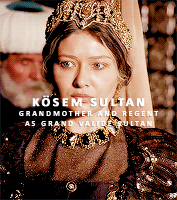


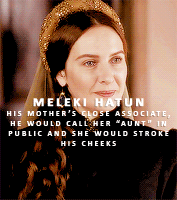
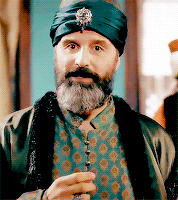
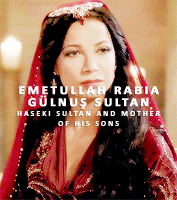

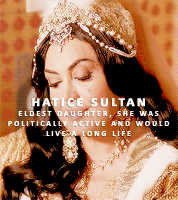

Mehmed IV of the Ottoman Empire + the women in his life
#history#ottoman history#historyedit#mehmed iv#kosem sultan#turhan hatice sultan#atike sultan daughter of ahmed i#meleki kalfa#emetullah rabia gulnus sultan#afife kadin#hatice sultan daughter of mehmed iv#fatma emetullah sultan daughter of mehmed iv#ottomanladiesedit#*womeninlife
2K notes
·
View notes